How a Toilet Works – Well Explained
Last Updated on July 28, 2023 by toilethaven
How Does A Toilet Work?
From the time flush toilets were invented in 1596 by Sir John Harington, the water closets, as they were mostly called, have gone through tremendous innovations, but the principle upon which they work remains the same.
A toilet works by depositing a large quantity of water from the tank into the bowl quickly. By so doing, a siphon effect is created at the toilet, which sucks the water and waste inside the drain line, thereby flushing the toilet.
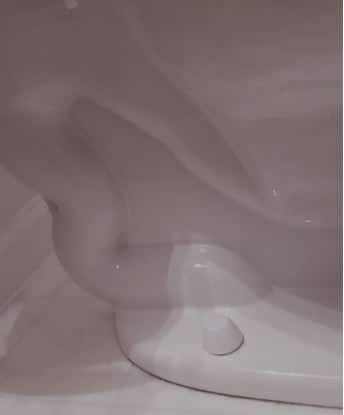
A toilet flushes because of the force of gravity and the siphoning effect. When you flush a bathroom, a large amount of water moves from the toilet tank to the toilet bowl within seconds which triggers the siphoning effect at the toilet trap.
It is the process of dumping a large amount of water within a short period that enables the toilet to flush. To put this into context, try pouring water with a hose pipe into your toilet bowl. It will not flush.
Flush toilets are the most common type of toilet, but there are many more types of toilets, as we will see in this post.
Toilet Plumbing Diagram
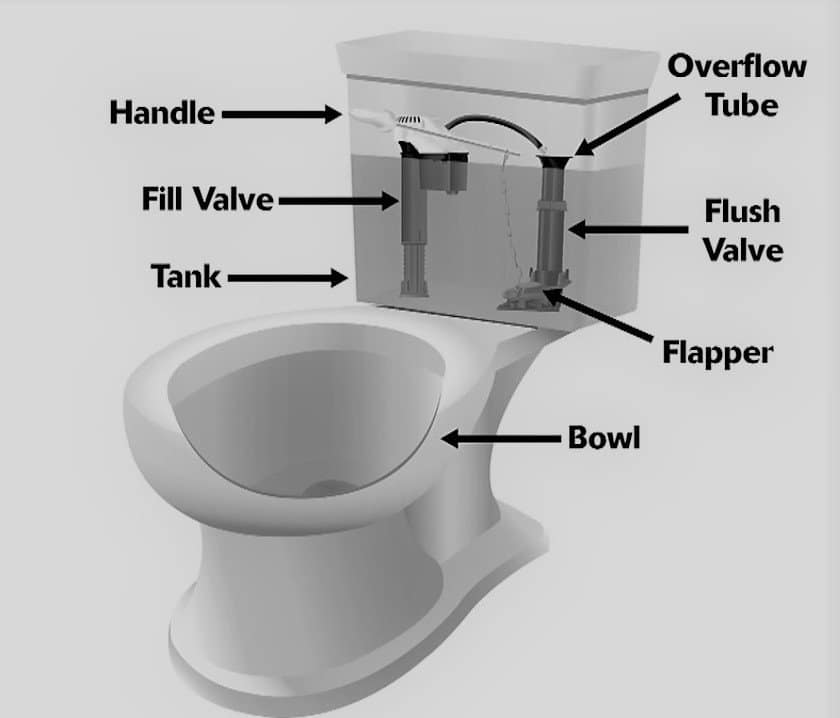
Flush toilets use water to evacuate human waste from a toilet bowl which then flows through the toilet drainpipe and eventually to the city’s sewer lines.
Parts of a Toilet – How a Toilet Works
The following are the different parts of a toilet that explain how a toilet works from start to finish.
1. Toilet Handle
The toilet handle for most modern toilets are normally chrome-plated and are located on the left-hand side of the tank. This is where the flushing process is initiated. Pull the handle down.
The buttons are normally on top of the toilet tank for dual flush toilets. You only need to push them. Here is how to replace a toilet handle.
If you would like to buy a solid toilet handle to replace yours, I have written an in-depth review. Read it here.
2. Lift chain
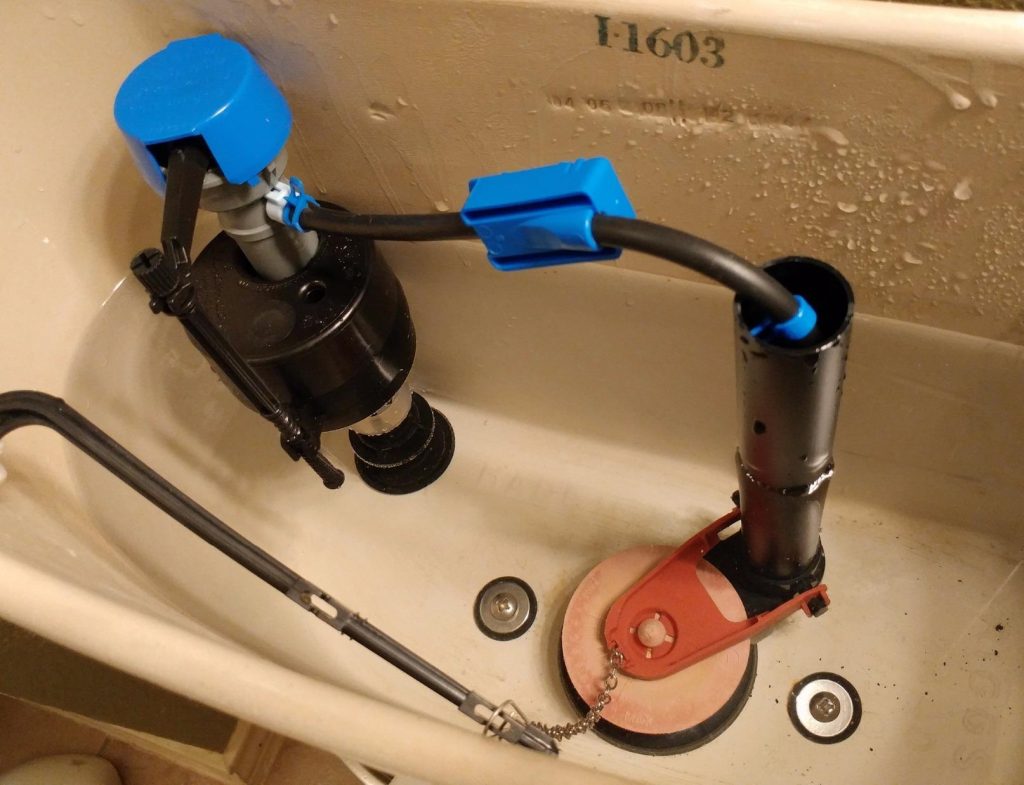
The lift chain is a light chain that connects the toilet handle from the inside to the toilet flapper. When you push the toilet handle down, the lift chain, which was, until that time, slack, gets tension and lifts the flapper off the flush valve.
A dual-flush toilet does not have a lift chain. The flushing buttons are positioned on top of the dual flush valve assembly, which has a flush valve gasket at the bottom.
3. Toilet Flapper
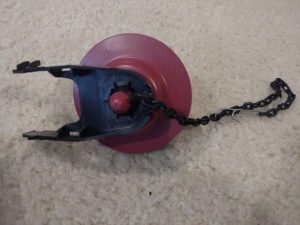
A toilet flapper is a rubber seal that sits on the flush valve to create a seal between the toilet tank and the bowl. During flushing, the lift chain lifts off the flapper allowing water to leave the tank and enter the bowl. When the tank is empty, the flapper goes back to position to create a seal that allows the tank to fill and stay full.
A damaged toilet flapper is most responsible for a continuously running toilet. Run how to replace a toilet flapper in this post.
4. Toilet Flush Valve
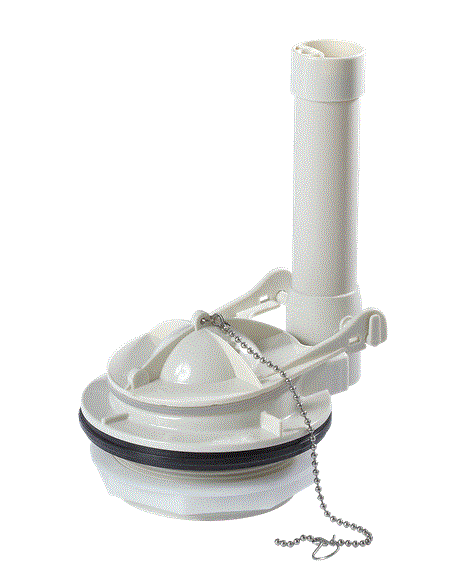
A flush valve is an opening at the bottom of the toilet tank that allows water to enter the bowl from the tank. Flush valves differ in size from 2 to 4 inches. A bigger flush valve means a large amount of water enters the bowl quickly, resulting in a powerful flush.
5. Toilet Tank to Bowl Gasket
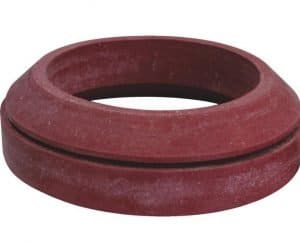
The toilet tank-to-bowl gasket, also known as a spud washer, is a rubber seal that seals the outside of the toilet flush valve. It prevents water from leaking as it leaves the tank and enters the bowl.
If your toilet is leaking between the tank and the bowl, you most likely need to replace the toilet tank with a bowl gasket or tank bolts. Check out how to do so in this post.
6. The Toilet Bowl
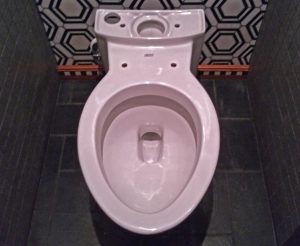
Toilet bowls are either round or elongated, but that does not affect how a toilet works, although some people believe round toilets flush better than elongated toilets.
As the water leaves the flush valve, about 20% goes around the toilet rim and enters the bowl through tiny holes under the rim. This helps to clean the enter bowl.
The bulk of the water enters the bowl through a siphon jet aiming straight at the toilet trap, where the actual flushing happens.
7. Toilet Trap
The toilet trap is a U-shaped bend at the bottom of the toilet. This is where the siphoning effect happens. A toilet trap has two main functions:
- It holds a small amount of water at the bottom of the toilet, which prevents sewer gases from coming up to your toilet.
- It acts as an anti-clogging agent. It traps most things that would otherwise clog the toilet drainpipe further below.
When a large amount of water is suddenly released inside the toilet bowl, the toilet trap/siphon tube immediately fills with water which rapidly flows inside the drainpipe, sucking the contents of the bowl with it. This is called the siphoning effect. When all the water and waste have been siphoned out, air enters the trap ending the flushing process with a gurgle.
8. Toilet Fill Valve
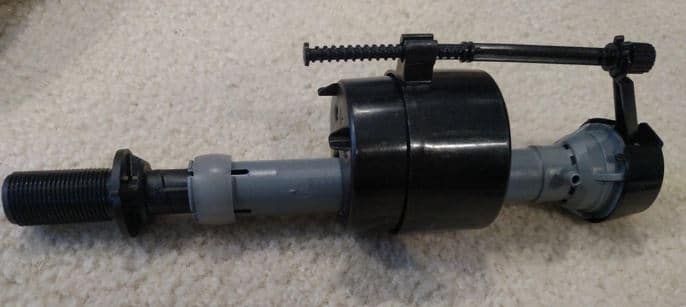
The toilet fill valve is connected to the water supply line and is responsible for filling the tank with water after every flush. It is also connected to the toilet float and the refill tube.
I have written a detailed post review of some of the best toilet fill valves for replacement. Read it here.
9. Toilet Float
A toilet either uses a ball float or a float cup/cylinder. The toilet floats regulate the opening and closing of the fill valve and the water level in the toilet tank.
Prior to flushing the toilet, the float is normally floating at the top of the tank. After flushing the toilet, the float moves to the bottom of the tank, which in turn opens the fill valve.
The float moves up gradually as the tank fills with water until it reaches the top of the tank, where the water level has been set, and the fill valve closes.
Need to know how to adjust a toilet float? Check out this post.
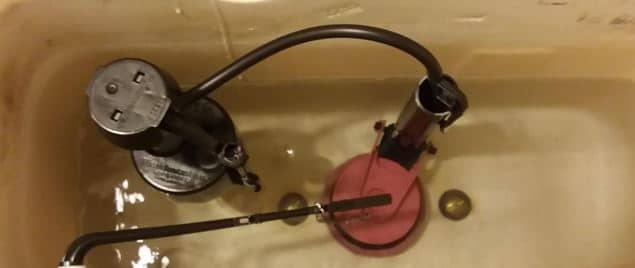
10. Refill Tube.
The refill tube is a small, mostly black tube connected from the fill valve to the overflow pipe. As the fill valve fills the toilet tank with water, the refill tube sends a small amount of water back to the toilet bowl through the overflow tube. This is the water you see at the bottom of the toilet and prevents the foul smell from coming up to your bathroom
11. Toilet Overflow Tube
The overflow tube is a large tube at the bottom of the toilet tank that prevents water from overflowing from the tank and flooding the bathroom.
If the water level in the tank rises above the required level, the overflow tube sends the water back to the toilet bowl. This is normally one of the issues when your toilet is continuously running.
The water level in the toilet tank should be about ½ inch below the overflow tube. It is correct to say the toilet overflow tube is the toilet’s failsafe.
12. Toilet Tank Lid
The toilet tank lid prevents dirt from entering the tank. It also provides a means for accessing the inside of the toilet tank for repairs.
Dirt can interfere with the toilet’s work, especially if trapped under the flapper valve. The flapper will therefore be unable to seal, and you will have a toilet running continuously.
13. Wax Ring
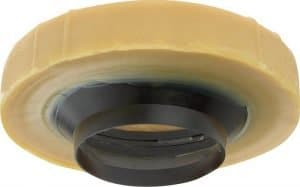
A wax ring is a piece of molded wax on a plastic ring placed between the bottom of the toilet and the toilet flange. It creates a seal that prevents flush water and sewer gases from leaking into the bathroom.
An alternative to a wax ring is a rubber gasket seal that works the same way as a wax ring but is less messy and easier to install.
Check out this post to learn everything you need to know about toilet wax rings.
14. Toilet Flange
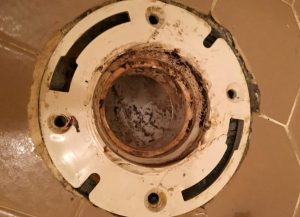
A toilet flange, also known as a closet flange, is a pipe fitting that is screwed into the bathroom floor to connect the bottom of the toilet to the drainpipe.
A broken toilet flange will make the toilet start to wobble and, after some time, start leaking from the base, and an awful sewage/urine smell will fill the bathroom. Here is how to replace a toilet flange.
An offset toilet flange converts a 12-inch rough-in toilet into a 10-inch or 14-inch rough-in toilet. Read more about it here.
15. Toilet Bolts
Toilet bolts are hooked up on the toilet flange and are used to secure the toilet firmly to the toilet floor. Color-matched toilet bolt caps are used to cover the exposed parts of the bolts for aesthetic purposes.
16. Shut-Off Valve

The toilet shut-off valve is located at the rear wall of the toilet. It is used to turn off and on the water supply to the toilet. To open the toilet, turn it counterclockwise and clockwise to turn it off.
If you would like to replace your toilet shut-off valve, this is how to do it.
17. Water supply line
The toilet water supply line is a braided stainless steel line connected from the shutoff valve to the toilet tank. It supplies water straight to the toilet fill valve.
Common Toilet Problems
1. Toilet Leaking at the Base
When you have a toilet that leaks at the base, the toilet wax ring is not sealing correctly, and hence flush water is leaking at the bottom of the toilet.
To fix this problem, remove the toilet and replace the wax ring. You could replace it with another wax ring or rubber gasket seal.
2. A Wobbly/Rocking Toilet
A wobbly toilet is caused by several factors, including loose toilet bolts, the toilet flange way above the floor, and an uneven floor where the toilet is installed.
Fixing a wobbly toilet starts by checking if the toilet bolts are loose. If they are tightened them. If they are not, use toilet shims to level the toilet.
If the wobbly toilet is leaking, you will need to first replace the wax ring before shimming the toilet.
3. Toilet Can’t Top Running
A toilet that can’t stop running points out to a defective toilet fill valve, flapper, or toilet float that has not been properly adjusted.
Toilet fill valves and flappers are cheap, and you can replace them alone. To adjust the water level in the toilet tank, look for a screw adjacent to the float and use a screwdriver to turn it clockwise or counterclockwise.
To raise the water level in the bowl, turn the screw clockwise, while to lower the water level, you will need to turn the screw counterclockwise.
4. Water Level in The Toilet Bowl is Too Low
When the water level in the bowl is too low, the following could be the problem:
- The refill tube is not connected to the overflow tube.
- The toilet fill valve does not fill the tank with enough water
- The toilet bowl is cracked
- The vent stuck is clogged
5. Toilet is Clogged
Toilets get clogged when something that is not supposed to be flushed is flushed. To unclog a toilet, use a plunger or a toilet auger. You could also unclog a toilet without a plunger using dish soap, a wire hanger, baking soda, + vinegar solution, or remove the toilet if it doesn’t.
6. Toilet Bubbles When Flushed
When a toilet bubbles when flushed, the drainpipe or the vent stuck are clogged. The bubbles are a result of the air in the drainpipe or vent stuck escaping.
Unclogging the drain pipe or vent stuck should be able to resolve the problem. If, however, you notice that the toilet is bubbling when the bathtub or other drains in your house drain water, the main drainpipe is clogged, and you will need to either call a plumber or unclog it yourself.
If a clogged drain is left for a long without being unclogged, the waste will start backing up.
7. Toilet Leaking Between The Tank and The Bowl
If a toilet is leaking from between the toilet tank and the bowl, it means the toilet tank to bowl gasket, also called a spud washer, is leaking and will need to be replaced.
To replace the toilet tank with a bowl gasket, you will need to remove the toilet tank first, remove the old gasket, install the new one then install the toilet tank.
How Much Water Does a Toilet Use?
In terms of water consumption, toilets have come a long way. Old toilet models used 3 to 6 gallons of water per flush. Even with the high consumption, they were still very inefficient.
Modern toilets use between 0.8 to 1.6 gallons of water per flush. Dual flush toilets give the user an option to use half a flush or a full flush, depending on the waste.
If a toilet is rated as 1.28/1.6 GPF, you can use 1.28 or 1.6 gallons of water per flush. Governments also control the consumption of the toilets being sold.
For instance, all toilets sold in California must use 1.28 gallons of water per flush or less.
Types of Flush Toilets
1. Gravity flush toilets
Gravity flush toilets are the most common type of flush toilets. They have a toilet tank on top of the bowl, which enables the water to flow from the tank to the bowl with the help of gravity.
2. Pressure-assisted toilets
Pressure-assisted toilets have a secondary tank inside the main toilet tank called a pressure vessel. The pressure vessel has a valve that draws in air, which, when mixed with the inflowing water, creates a powerful but loud flush.
3. Upflush/macerating toilets
An Upflush/macerating toilet is a toilet with a unit at the back that shred/grinds human waste mixed with flush water using rotating blades into a slurry. Unlike other toilets, the waste is pumped from the back of the toilet upwards to the sewer drain. They are the perfect basement toilets.
4. Single-flush toilets
Single-flush toilets use a specific amount of water per flush. If, for instance, a toilet is rated 1.28 GPF. It means it uses 1.28 gallons per flush.
5. Dual flush toilets
Dual Flush toilets give the user a chance to use little water or a bit more water depending on whether the waste is liquid or solid. If a toilet is rated as 1.28/1.6 GPF, it uses 1.28 gallons of water to flush liquids and 1.6 gallons to flush solids.
6. Tankless toilets
Tankless toilets use water under high pressure from the supply lines to flush a toilet, negating the need for a toilet tank. They use a flushometer device to release a metered amount of water during each flush.
7. One-piece toilets
One-piece toilets are toilets that are that made with the toilet tank and the toilet bowl attached.
8. Two-piece toilets
Two-piece toilets are the kind of toilets that are made with separate bowls and tanks. These toilets are joined together during installation.
9. Elongated toilets
Elongated toilets have a longer oval-shaped toilet bowl. These toilets are more comfortable than round toilets and take up more space. Elongated toilets have a bowl of an average of 18.5 inches in length.
10. Round-front toilets
Round-front toilets have a circular bowl shape. They take up less space than elongated toilets and are less comfortable. The length of the round-front toilet bowl is 16.5 inches.
11. Compact elongated toilets
Compact elongated toilets are designed to take up the space equivalent to a round toilet but still provide the comfort of an elongated toilet.
12. Overhead toilets.
Overhead toilets are old toilets with a tank mounted high above the bathroom wall. The tank was mounted high to give the flush water speed as they moved down to the bowl.
13. Standard-Height toilets
Standard-height toilets are common toilets with a bowl height of about 14.5 inches.
14. Comfort-Height toilets
Comfort height toilets, also called universal/right/ADA-compliant/chair height toilets, have a toilet bowl height of between 16.5 and 19 inches.
15. Skirted Toilets
These are toilets that have a concealed trapway. Cleaning this toilet is way easier than non-skirted toilets.
16. Wall-hung toilets
Wall-hung toilets that are mounted on the bathroom wall. Their tanks are concealed in the wall, supported by a frame called a carrier, also used to mount the bowl. A wall called a ledge wall is afterward used to conceal the tank and the carrier.
17. Floor-mounted toilets
Floor-mounted toilets are the most common type of toilets mounted on the bathroom floor using bolts and draining their waste through the floor.
Toilet Dimensions and Features.
Toilets are mostly made of vitreous china material, although old models had plastic or steel water tanks. They weigh between 70 to 120 pounds and can last for many decades. Toilet parts like fill valves, flappers, and seals will need to be replaced frequently.
Toilets in the USA have a bolts spread of 5.5 inches. This is the distance between the holes used to mount a toilet seat.
The standard rough-in for most toilets is 12 inches, but 10 and 14-inch rough-in toilets exist. You can replace a toilet with another with a smaller rough-in but not a bigger rough-in. For instance, you can replace a toilet with a rough-in of 14 inches with one with a rough-in of 12 inches but not vice versa.
Most building codes require that toilets must have at least a 15-inch clearance between the center of the drainpipe and each sidewall and a free space of 24 inches in front of the toilet. Apart from that, they must be at least 30 inches from the nearest sanitary fixture.
Other Types of Toilets
How Composting Toilets Works
Composting toilets are a type of toilet that biologically break down human waste through a process known as decomposition to form an organic matter which can be used as organic manure.
Modern composting toilets are sleek and beautifully designed to fit easily in the most sophisticated bathroom. They are a great backup for your home, especially when the water supply is off.
Examples of composting toilets include:
- Natures Head Self-Contained Composting Toilet
- Sun-Mar Self-Contained Composting Toilet
The advantages of composting toilets are that they are easily portable and do not need plumbing works to be installed prior. They also conserve water and are easy to use.
How a Vault Toilet Works
A vault toilet is a non-flush toilet on an underground tank (vault) built in an area without access to running water to hold human waste temporarily. The vaults are either made of concrete or plastic. A concrete slab is constructed on top of the vault, where the buildings hosting the bathrooms are then erected.
Unlike Pit Toilets, vaults toilets are emptied from time to time, and the waste is taken to the municipal sewage treatment facility.
How Pit Toilets Work
Pit toilets, also called pit latrines, are constructed by digging a pit on the Earth (12-50 feet) where a small cubicle is erected around the pit. Wood or concrete is used to cover the pit and only leaves a small hole in the middle for passing the waste.
Pit toilet users use the squatting technique. Few of these toilets have a raiser and a toilet seat where the user sits.
The waste in a pit toilet is never removed, and when it is full, it is abandoned, and the user digs another pit. They are not very environmentally friendly but are the best solution for remote and underdeveloped areas without access to piped water.
Pit toilets have greatly helped to fight waterborne diseases like cholera and typhoid in developing countries. Prior to building pit latrines, the people used to defecate in the open fields/bushes.
How a Portable Toilet Works
Portable toilets, or porta potties as they are commonly called, can be transported from one point to another. The most common use of portable toilets is camping toilets which could be as easy as a bucket or a more sophisticated flush-type portable toilet.
These are the different types of portable toilets:
1. Flush type Portable toilets
These portable toilets work like ordinary flush toilets at home. They have a toilet bowl, a toilet seat with a lid, a freshwater tank, and a holding tank for storing the waste temporarily.
The waste tank is normally bigger than the freshwater tank and is conveniently positioned below the freshwater tank and the toilet bowl. It is attached to the freshwater tank and the bowl using side latches.
A chemical is normally put inside the waste tank to break down the feces and tissue paper into an easy-to-pour slurry and also deal with the odor. The waste tank also has a spout for pouring out the waste when required.
A sliding valve seal is normally in place at the top of the waste tank, which prevents the waste from leaking and also contains odors.
Flush-type portable toilets can serve you for an average of 50 flushes. Here are examples of flush-type portable toilets:
- Thetford Curve Portable Toilet
- Camco Premium Portable Travel Toilet
- Dometic Portable Toilet
2. Bucket-type Portable Toilets
Bucket-type portable toilets are the simplest portable toilets. They only have a 5-gallon bucket with a toilet seat and lid that snap on top of the bucket.
To use these toilets, you put a waste bag with poo powder inside the bucket, snap the seat back on then proceed to do your business. Some people even use the ordinary kitchen waste bag with kitty litter which works just as fine.
These portable toilets are lightweight and easily affordable. Some of the best bucket-type portable toilets include:
- Reliance Products Luggable Loo Portable Toilet
- Camco Portable Toilet Bucket
3. Collapsible portable toilets
Collapsible portable toilets are designed with legs that can be collapsed when the toilet is not in use to form compact portable toilets. These are especially great if you need to store them in a tight place.
Collapsible portable toilets do not also need water to work. They use toilet bags with poo powder to break down the waste and deal with the order.
Some of these portable toilets include:
- Cleanwaste Portable Toilet
- Reliance Fold-to-Go Collapsible Portable Toilet